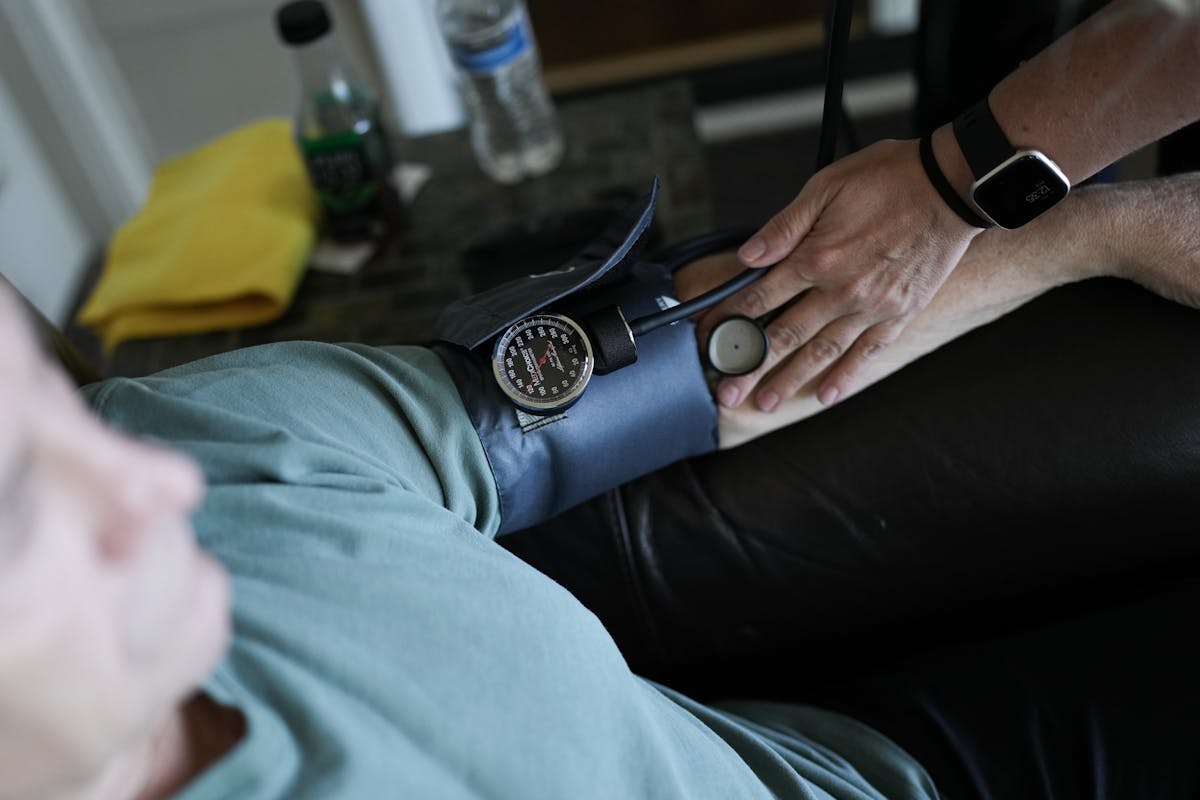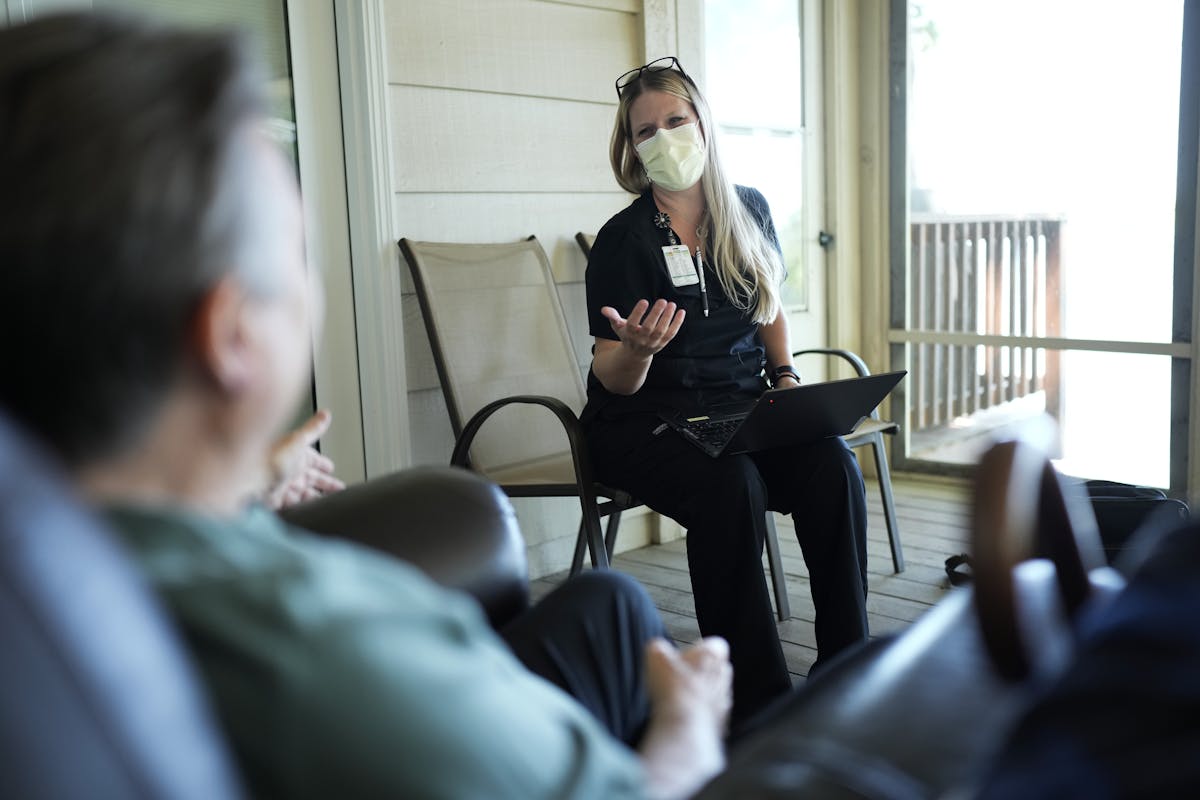Minnesota's largest hospitals saw revenue rebound in 2021 — but uncertainty remains
Terry Johnson's shoulder pain was bad and getting worse near the end of 2020, but he decided to delay surgery.
Johnson was reluctant to seek care when so many were sick with COVID-19 — he's been wary of catching illnesses since a major heart operation a few years ago. The Chaska resident knew hospitals were under considerable stress and figured other patients had greater need for a bed.
But by March 2021, he could no longer tolerate the pain; Johnson finally sought treatment at Abbott Northwestern Hospital in Minneapolis.
"Before, if you came here and wanted to shake my hand, I'd have to take my left hand and lift my right hand up," said Johnson, 69. "Now, I can do anything. It's almost like a miracle to me."
As patients like Johnson returned for care last year following pandemic-related delays in 2020, Minnesota's nine largest hospital operators saw revenue rebound.
Median revenue in 2021 jumped by 12% to $2.6 billion and two of the health systems returned to profitability after a distressing previous year, according to the Star Tribune's annual look at financial performance at the biggest health care nonprofits in Minnesota.
Whereas the median operating margin across the health systems was just 0.3% in 2020, it improved last year to 3.3%.
"The types of care that were being delivered between 2020 and 2021 probably shifted a bit, where 2021 brought a bit more elective services — things that tend to have a better margin and people who had waited kind of caught up," said Jean Abraham, a health economist at the University of Minnesota.
Revenue improvement, however, does not mean health systems have recovered financially from the pandemic, said Nancy Kane, a researcher in health policy and management at the Harvard T.H. Chan School of Public Health.
Hospitals that lost revenue in 2020 with the temporary shutdown of non-emergency care for the pandemic are now grappling with surging labor costs. "The story's not over," Kane said.
Many health care workers have retired early or left the profession following the stress of COVID-19, she said. Hospitals, in turn, are struggling to fill gaps by paying top dollar for temporary "traveling" nurses, and by using overtime and premium pay to stretch the existing workforce.
Considering the whiplash of disruptions — from hospitals sitting relatively empty at the outset to getting slammed last winter by staffing shortages — it's still too early to assess the pandemic's overall impact, said Sayeh Nikpay, a health policy researcher at the U.
"I think we won't have a really clear picture of what is happening to health care finance — and why — until we're pretty far out from where we are now," Nikpay said.
The Star Tribune's annual survey of financial performance at nonprofit health care groups focused this year on the largest dozen.
The list includes three health insurers and eight health systems, each of which operates at least one hospital plus clinics. It's rounded out by Bloomington-based HealthPartners, which is both an insurer and health care provider.
The Mayo Clinic in Rochester again reported the most revenue — $15.7 billion — followed by HealthPartners and Eagan-based Blue Cross and Blue Shield of Minnesota, each with more than $7 billion.
Data from audited financial statements show the health systems and health insurers have had an inverse relationship over the past three years: financial improvement for one group came as fortunes diminished for the other.
As a group, the insurers Blue Cross, Medica and UCare became more profitable between 2019 and 2020. Then, their median operating income fell closer to breakeven in 2021, according to the Star Tribune analysis.
Meanwhile, health systems — a group that includes HealthPartners for the analysis — saw median operating income fall in 2020 to $7.3 million on $2.19 billion of revenue. Last year, their operating income improved to a median of $82 million on revenue of $2.45 billion.
Without special government funding to cope with the pandemic, Minnesota's largest health systems would have lost money on operations in 2020. As a group, they collectively used about $1 billion in COVID funding that year.
Better financial results in 2021 came even as the nonprofits collectively used much less in special COVID funding — about $300 million.
But this improvement is not reassuring to officials at the Minnesota Hospital Association. The trade group argued the Star Tribune's analysis should exclude Mayo, which has large operations outside Minnesota, and calculate medians without including the COVID relief funds.
With those adjustments, the numbers would show that hospitals between 2020 and 2021 went from "drowning" to "barely treading water," said Dr. Rahul Koranne, chief executive of the Minnesota Hospital Association.
In April, the hospital association's annual report on financial results looked at numbers through 2020 and concluded that health systems faced a "dire financial outlook."
But Allan Baumgarten, an independent health care analyst in St. Louis Park, came to a more optimistic conclusion this spring in his annual report on hospital finances, which also focused on 2020.
Baumgarten factored income from investment returns, philanthropy and government grants — not just health care operations, as did the hospital association report.
"By my analysis, you had a couple of the major systems that actually improved their performance between 2019 and 2020," he said. "I don't think 2020 was as dismal or as dire as some have portrayed it."
The Star Tribune analysis focuses on income from health care operations, but also looked at non-operating income and found median net income — a figure that incorporates both types of earnings — grew significantly in 2021.
Hennepin Healthcare, which operates HCMC in Minneapolis, fell below the Star Tribune median last year with an operating margin of 2.2%. Patient volumes in most areas have not returned to pre-COVID levels, so the medical center has been forced to cut costs, said Derrick Hollings, the chief financial officer.
"We're still not back to what I would consider to be our normal trend line," he said.
Children's Minnesota went from an operating loss in 2020 to managing a relatively small profit last year, said Brenda McCormick, the chief financial officer. The margin of 1.5% was short of historical norms that she said range from 3% to 5%.
"We're not expecting to get back to what I would call those more normal operating margins really until later in 2023," McCormick said. "And now we've got the inflationary pressure, as well."
St. Cloud-based CentraCare saw above-median income in 2021 as surgical patients returned, said Mike Blair, the chief financial officer.
The health system's fiscal year runs from July to June, so executives already have a pretty good sense for how fiscal 2022 will shake out — and margins are looking much tighter, he said.
With expenses growing for temporary nurses and other measures to fill staffing gaps, CentraCare expects operating income, excluding one-time factors, to be closer to breakeven.
"Labor costs will be about $75 million higher than what they were last year, up by like 7%," Blair said.
Between 2020 and 2021, Allina Health System went from an operating loss of $36.2 million to income of $128.8 million.
Allina started making changes to boost efficiency before the pandemic and it paid off last year, said chief financial officer Ric Magnuson. Insurers are providing financial rewards, he said, to health systems that successfully provide more care outside hospitals.
That shift at Allina includes a "hospital-at-home" program, where certain patients are discharged early or aren't even admitted from the ER. Instead, they get better at home with a combination of in-home visits from nurses and paramedics plus remote monitoring and telehealth visits with physicians.
Allina estimates the program has helped patients avoid more than 5,000 days of hospital care since the program's start in 2020, said Dr. Emily Downing, a system clinical officer. Patient outcomes have been good.
"As we think about, as a community and a society, how can we help to contain health care costs that really are growing pretty substantially, this is a key opportunity — to shift care delivery that's great for our patients and also a more affordable alternative," she said.
Terry Johnson liked his at-home care experience.
More than a year after his shoulder surgery, the Chaska resident went back for a hip replacement at Abbott Northwestern, which is part of Allina. He spent one night in the hospital and then three days in the hospital-at-home program.
The care team provided him with a tablet computer for reporting vital signs, including readings beamed via Bluetooth from a blood pressure cuff. A retired salesman, Johnson said he preferred the telehealth visits to talking with doctors at the hospital, because they didn't have to wear masks when talking on a screen.
"I feel like I can tell a lot by looking at a person's face," he said, adding that he believes it helps caregivers spot changes.
The joint repairs haven't been a surprise to Johnson, who's seen peers receive similar procedures in recent years. With pastimes ranging from college football and boxing to barefoot waterskiing in later years, Johnson said he's "played hard my whole life."
So far, recovery from the hip replacement hasn't been easy, but he said using the hospital-at-home technology has been a breeze.
"The way it helped me," he said, "I know it can help other people."



